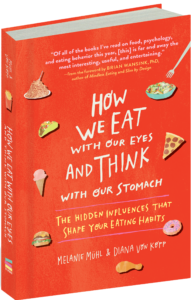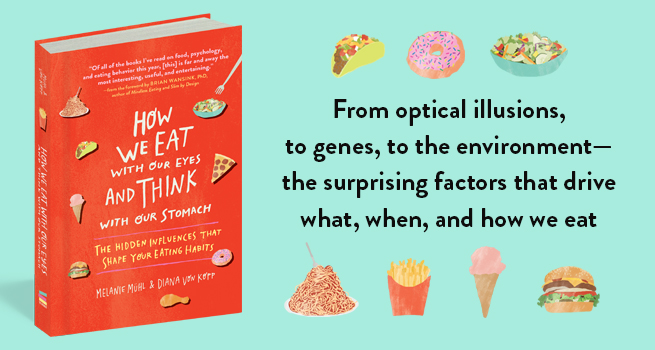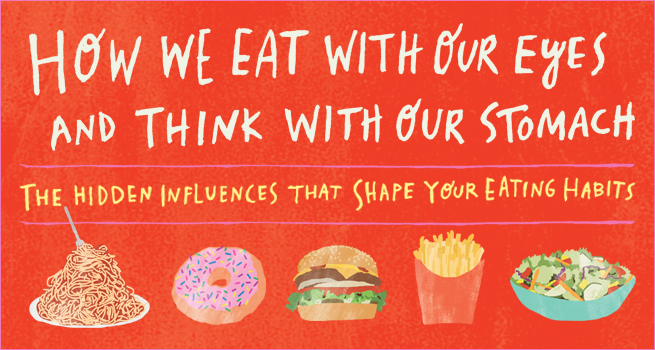The holidays are fast approaching and for many of us that means special treats: brown sugar with a side of yams, too many kinds of pie to choose just one, hot chocolate with marshmallows and whipped cream, and so. many. cookies. A few extra pounds come January is basically part of our cultural identity.
 And that’s not just because we have an undiscerning love for turkey and gravy. How andwhat we eat is determined by so much more than our taste buds. Understanding the hidden influences on our eating means examining psychology, neuroscience, popular culture, and more. Luckily, Melanie Mühl and Diana von Kopp have written a book to help us identify and outsmart our impulses in order to eat better. How We Eat with Our Eyes and Think with Our Stomach: The Hidden Influences That Shape Your Eating Habits explores how our eating decisions tread the line between conscious and subconscious–the size and color of your plate, the placement of products in a supermarket, even the order in which you sit when out with friends can all influence how you eat.
And that’s not just because we have an undiscerning love for turkey and gravy. How andwhat we eat is determined by so much more than our taste buds. Understanding the hidden influences on our eating means examining psychology, neuroscience, popular culture, and more. Luckily, Melanie Mühl and Diana von Kopp have written a book to help us identify and outsmart our impulses in order to eat better. How We Eat with Our Eyes and Think with Our Stomach: The Hidden Influences That Shape Your Eating Habits explores how our eating decisions tread the line between conscious and subconscious–the size and color of your plate, the placement of products in a supermarket, even the order in which you sit when out with friends can all influence how you eat.
How We Eat with Our Eyes and Think with Our Stomach tackles over 40 questions on how we consume, from ‘why do you always fail to stick to the shopping list?’ to ‘why do you crave junk food when you’re sad?’ In the spirit of the holidays, the chapter excerpted below asks: ‘why don’t you know when you’re full?’
In the 1980s, Allan Geliebter conducted an experiment at Columbia University in New York in which he introduced balloons into the stomachs of his test participants. Then he pumped water into the balloons, in increments of 100 milliliters. After each incremental step, the participants were asked how full they felt. The results showed that lean people have a stomach capacity close to 1,100 milliliters, while the obese have a capacity of 2,200 milliliters or even more.
People who rely only on the fullness signals sent from their stomach wall to their brains run the risk of eating more food than is good for them. Fortunately our bodies have additional sources of information, such as the nutrient density of a food. A chocolate bar may not stretch the stomach, but it satisfies the body’s need for carbohydrates and fats. An important hormone in this process is ghrelin. Released in the stomach lining, it sends signals to the brain, where it influences complex processes such as appetite, sleep, addiction, and satiety. When you are hungry, your ghrelin levels increase; when you take in food, the production of ghrelin decreases. Carbo-hydrates lower your ghrelin levels particularly quickly, but the levels rise again soon after. Fats, on the other hand, lower ghrelin levels more slowly and keep them low for a longer period of time, which explains why a handful of nuts keeps hunger at bay for longer than a donut.
The problem is that it can take up to twenty minutes for hormone-driven fullness signals to reach the brain and give the order to stop eating—and twenty minutes is plenty of time to eat one, two, or even three too many high-energy snacks such as a Mars bar.
Given how complicated it is to correctly interpret the signals from our own bodies, what stops us from going for third and fourth helpings? From a purely physiological point of view, nothing is keeping us from having thirds and fourths. This was shown in an experiment with amnesia patients who were offered a second meal after completing a first one. As they could not remember, they ate two complete meals in a row—apparently without feeling full. Even when they were offered the same meal a third time, they didn’t hesitate to tuck in. Only the intervention of the researcher stopped them from eating a full third meal. We’re incredibly dependent on the memory of past meals and are easily led by stimuli.
So does common sense keep us from constant eat-ing after all? Yes and no. Habits play an important part as well. Generally, we eat as much as we’re used to eating. Or until we’ve cleaned our plate. A clean plate is one of the strongest cues of all: We trust that we will automatically feel full with the last mouthful and happily ignore the fact that we might feel satisfied before then.
 Participants in an experiment conducted by the Food and Brand Lab at Cornell University were led to eat continuously via a simple trick. Using a hose and pump connected to bowls fixed to the table, the study leader kept topping up the participants’ tomato soup—and they kept slurping the never-ending sup-ply of soup. Some continued to eat even after the experiment had finished. One participant, who had eaten three times as much as his neighbor whose bowl hadn’t been kept topped up, declared the soup “pretty filling.” Unconsciously relying on the empty-plate signal, those who had eaten from the manipulated bowls consumed on average 73 percent more than the control group.
Participants in an experiment conducted by the Food and Brand Lab at Cornell University were led to eat continuously via a simple trick. Using a hose and pump connected to bowls fixed to the table, the study leader kept topping up the participants’ tomato soup—and they kept slurping the never-ending sup-ply of soup. Some continued to eat even after the experiment had finished. One participant, who had eaten three times as much as his neighbor whose bowl hadn’t been kept topped up, declared the soup “pretty filling.” Unconsciously relying on the empty-plate signal, those who had eaten from the manipulated bowls consumed on average 73 percent more than the control group.
The fact that we usually eat from regular plates doesn’t devalue the significance of the study. At home we happily shuffle between the kitchen and the couch to replenish our plates with small portions. This means that we lose track of the amount of food we’re consuming. When we divert our attention from what and how much we’re eating to other things, such as watching television, we fall into the same trap. Participants in an experiment who played solitaire on a computer while eating felt less full afterward than the control group who concentrated on their meal, and the solitaire players felt hungry again sooner.
Speaking of appetite, according to a study con-ducted in 2013, bacteria in your gut can affect your appetite, too. In her book Gut: The Inside Story of Our Body’s Most Underrated Organ, Giulia Enders writes, “Late-night cravings for chocolate-covered toffees followed by an entire bag of party pretzels do not originate in the organ that calculates our tax returns. Not our brains but our guts are the home of gangs of bacteria that crave hamburgers after three days on a diet.” And what is more, bacteria are also at play when it comes to feeling full. According to Enders, “Several studies have shown our satiety signal transmitters increase considerably when we eat the food our bacteria prefer. What our bacteria prefer is food that reaches the large intestine undigested, where they can then gobble it up. Surprisingly enough, those foods do not include pasta and white bread ;-).” Much better options are potatoes, endives, garlic, onions, and parsnips.
In any case, in order to regain control of your calorie intake, it’s advisable to eat mindfully. Not on the go, but at the table. In her book First Bite: How We Learn to Eat, Bee Wilson pleads for more mindful-ness: “If we are going to change our diets, we first have to relearn the art of eating.” It is impossible, she explains, to develop a healthy relationship with food as long as we ignore the signals of our own bodies and instead listen to external cues such as portion size to tell us when we’re full.
FOOD FOR THOUGHT: Do you tend to clean your plate every time you eat? Most of us do, and it’s a habit we would benefit from breaking. Pay attention to your body. Do you feel full after only half a portion? Save the rest for later! Don’t eat while you’re distracted by work or television. It sounds more com-plicated than it is. Sometimes a little trick such as reducing the size of your plate is all it takes. And sometimes it’s better for food to go to waste than to your waist!



